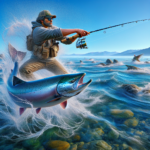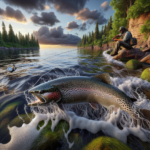Bluefin Tuna Fishing in Massachusetts’ Coastal Waters

Introduction
Did you know that the Atlantic Bluefin Tuna can reach speeds of up to 43 miles per hour? This incredible speed, combined with their immense size and strength, makes them one of the most sought-after game fish in the world. In Massachusetts’ coastal waters, Bluefin Tuna fishing is not just a pastime but a tradition that dates back generations.
This article will delve into the rich history and cultural significance of Bluefin Tuna fishing in Massachusetts, explore the best fishing techniques, provide detailed species information, and highlight top fishing spots. We will also cover essential gear recommendations, safety and conservation practices, and tips for planning your trip. Whether you’re a seasoned angler or a novice, this comprehensive guide will equip you with everything you need to know about Bluefin Tuna fishing in Massachusetts.
Understanding the intricacies of Bluefin Tuna fishing is crucial for anyone looking to master this challenging yet rewarding sport. From finding the best fishing spots to mastering advanced techniques, this guide aims to provide valuable insights that will enhance your fishing experience.
Background/Context
Historical or Cultural Significance
Bluefin Tuna fishing has a storied history in Massachusetts, dating back to the early 20th century. The state’s coastal waters have long been a hotspot for this prized species, attracting anglers from around the world. The annual Bluefin Tuna season is a significant event for local communities, contributing to both the economy and cultural heritage of the region.
Geographical Overview
Massachusetts’ coastal waters, particularly around Cape Cod and the islands, provide an ideal habitat for Bluefin Tuna. The region’s unique topography, characterized by deep offshore canyons and nutrient-rich waters, creates a perfect environment for these powerful predators. The local ecosystem, including abundant baitfish like herring and mackerel, supports a thriving Bluefin Tuna population.
Key Points/Details
Fishing Techniques
Technique Overview
Several techniques are effective for Bluefin Tuna fishing, including trolling, chunking, and jigging. Trolling involves dragging lures or bait behind a moving boat, while chunking uses pieces of bait to attract tuna to a stationary boat. Jigging involves using a weighted lure to mimic the movement of prey fish.
When and Where to Use
Trolling is most effective in open waters where tuna are actively hunting. Chunking works well in areas with strong currents, such as around underwater structures. Jigging is best used when tuna are feeding near the surface or at mid-depths.
Recommended Gear
- Rods: Heavy-duty trolling rods or jigging rods.
- Reels: High-capacity, high-drag reels capable of handling large fish.
- Lines: Braided lines with a high pound-test rating.
- Bait/Lures: Live bait like mackerel or herring, artificial lures like jigs and poppers.
Species Information
Species Overview
The Atlantic Bluefin Tuna is known for its immense size, with some individuals weighing over 1,000 pounds. They are highly migratory, traveling vast distances across the Atlantic Ocean. Bluefin Tuna prefer cooler waters and are often found near the surface or at mid-depths, where they hunt for schools of baitfish.
Best Practices
To successfully catch Bluefin Tuna, it’s essential to use strong, durable gear and to be patient. Pay attention to water temperature and baitfish activity, as these are key indicators of tuna presence. Early morning and late afternoon are often the best times to fish.
Location Information
Top Fishing Spots
- Stellwagen Bank: A marine sanctuary known for its rich biodiversity and abundant Bluefin Tuna.
- George’s Bank: Another hotspot with deep waters and strong currents that attract large tuna.
- Cape Cod Bay: Offers excellent fishing opportunities, especially during the summer months.
Regulations and Licenses
Anglers must adhere to local fishing regulations, which include obtaining a recreational fishing license and adhering to catch limits and seasonal restrictions. It’s crucial to stay updated on current regulations to ensure sustainable fishing practices.
Seasonal Considerations
Seasonal Variations
Bluefin Tuna fishing conditions vary throughout the year. Summer and early fall are peak seasons, with warmer waters attracting large schools of tuna. Winter and spring can also be productive, but anglers may need to venture further offshore.
Best Times to Fish
The optimal times for Bluefin Tuna fishing are early morning and late afternoon when tuna are most active. The summer months, particularly July through September, offer the best opportunities for catching large tuna.
Events and Tournaments
Event Overview
Massachusetts hosts several Bluefin Tuna fishing tournaments, including the annual Cape Cod Bay Tuna Tournament and the Massachusetts Bay Tuna Open. These events attract anglers from around the world and offer substantial prizes.
Preparation Tips
To prepare for a tournament, ensure your gear is in top condition, practice your fishing techniques, and familiarize yourself with the tournament rules. Pre-fishing the area can also give you a competitive edge.
Tips and Best Practices
General Tips
- Always check the weather forecast before heading out.
- Use a fish finder to locate schools of baitfish and tuna.
- Maintain a clean and organized boat to ensure safety and efficiency.
Avoid Common Mistakes
- Not using strong enough gear: Bluefin Tuna are powerful fish that require heavy-duty equipment.
- Ignoring water temperature: Tuna prefer cooler waters, so pay attention to temperature changes.
- Overlooking local regulations: Always stay updated on current fishing regulations to avoid fines and contribute to conservation efforts.
Advanced Techniques
- Using kites to present bait on the surface, mimicking injured prey.
- Employing live bait chumming to attract tuna to your boat.
- Mastering the art of “chunking” to create a feeding frenzy.
Gear and Equipment Recommendations
Essential Gear
- Heavy-duty trolling or jigging rods.
- High-capacity, high-drag reels.
- Braided lines with a high pound-test rating.
- Live bait like mackerel or herring, and artificial lures like jigs and poppers.
Optional Gear/Upgrades
- Fish finders and sonar equipment.
- Kite fishing setups.
- High-quality fighting belts and harnesses.
Where to Buy or Rent
Local shops like Goose Hummock Shops in Orleans and Riverview Bait & Tackle in South Yarmouth offer a wide range of fishing gear. Online stores like TackleDirect and Bass Pro Shops also provide extensive selections.
Safety and Conservation
Safety Tips
- Always wear a life jacket and ensure all safety equipment is on board.
- Check the weather forecast and avoid fishing in rough conditions.
- Stay hydrated and protect yourself from the sun.
Conservation Practices
- Practice catch and release to help sustain the Bluefin Tuna population.
- Respect local wildlife and avoid disturbing marine habitats.
- Follow all fishing regulations and report any illegal activities.
Planning Your Trip
Accommodations
There are numerous lodging options near popular fishing spots, including hotels, motels, and vacation rentals. Some recommended places include the Chatham Bars Inn in Chatham and the Sea Crest Beach Hotel in Falmouth.
Travel Tips
Massachusetts is easily accessible by car, plane, or train. Boston Logan International Airport is the nearest major airport, and there are several car rental services available. If driving, Route 6 is the main highway leading to Cape Cod and other coastal areas.
Additional Activities
When not fishing, visitors can explore local attractions such as the Cape Cod National Seashore, the Martha’s Vineyard, and the historic town of Plymouth. These activities make the trip enjoyable for families and groups.
Frequently Asked Questions (FAQs)
What is the best time of year to fish for Bluefin Tuna in Massachusetts?
The best time to fish for Bluefin Tuna in Massachusetts is during the summer months, particularly from July through September.
Do I need a special license to fish for Bluefin Tuna?
Yes, anglers need a recreational fishing license and must adhere to local regulations, including catch limits and seasonal restrictions.
What type of gear is best for Bluefin Tuna fishing?
Heavy-duty trolling or jigging rods, high-capacity reels, braided lines, and live bait or artificial lures are recommended for Bluefin Tuna fishing.
Are there any local fishing tournaments for Bluefin Tuna?
Yes, Massachusetts hosts several Bluefin Tuna fishing tournaments, including the Cape Cod Bay Tuna Tournament and the Massachusetts Bay Tuna Open.
Conclusion
Bluefin Tuna fishing in Massachusetts’ coastal waters offers an exhilarating experience for anglers of all skill levels. From understanding the best fishing techniques and gear to knowing the top fishing spots and seasonal variations, this comprehensive guide provides all the information you need to succeed. By following the tips and best practices outlined in this article, you can enhance your fishing experience while contributing to the conservation of this magnificent species. So gear up, head out to the waters, and enjoy the thrill of Bluefin Tuna fishing in Massachusetts.




